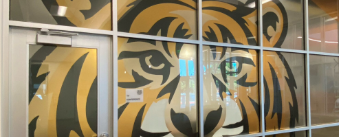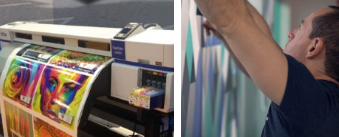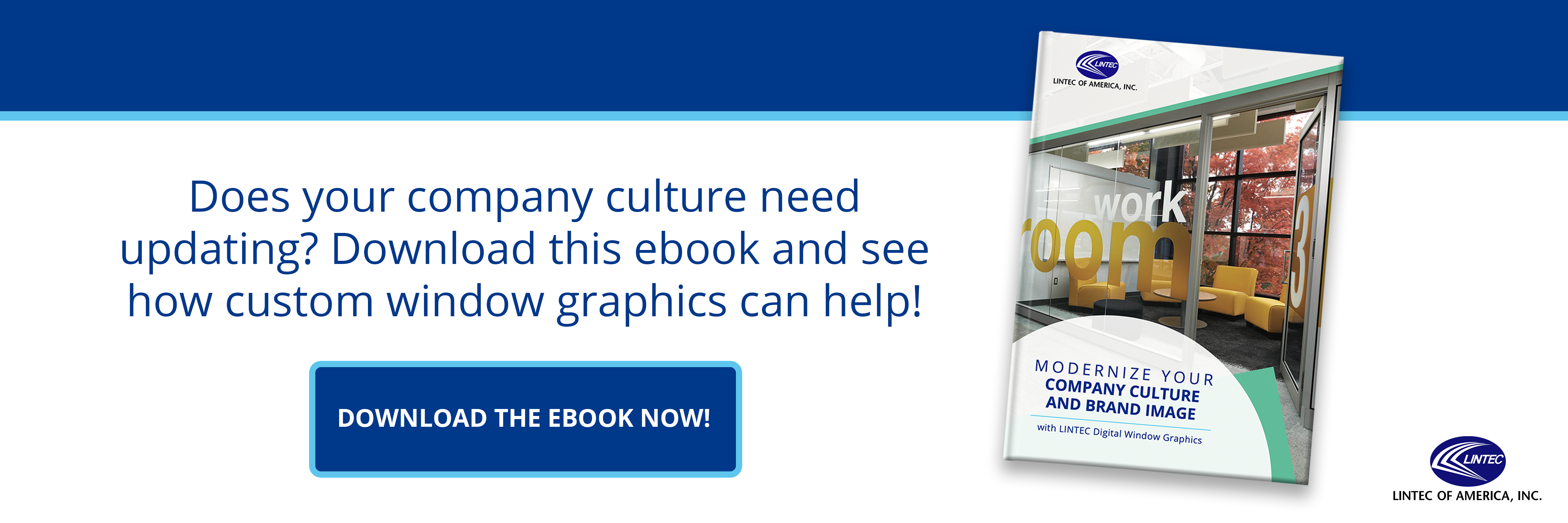
Windows are more than blank architectural features. With the help of a digital printer, each glass surface becomes a canvas for creativity and communication. Whether you’re a business looking to make a bold statement, a designer aiming to enhance a space’s ambiance, or a retailer striving to boost curb appeal, the right printed window film can transform ordinary glass into extraordinary experiences.
At LINTEC Digital Window Graphics, we’ve built our reputation on high-quality, polyester-based window films that offer unmatched clarity, durability, and versatility for digital printing applications. This soup-to-nuts guide will walk you through the essentials of choosing the perfect optically clear film, the best digital printing process for stunning designs that will bring your vision to life, and a few application ideas to inspire you as you elevate your space with LINTEC decorative window films.
Let’s explore how you can turn your windows into powerful visual tools that reflect your brand’s identity and vision.
Table of Contents:
- How to Select the Right Material for Your Window Film
- How to Pick a Printing Process for Window Graphics
- Applications & Ideas for Window Film Use in Businesses
- General Tips for New Users of LINTEC Films
- Transform Your Space with LINTEC: Durable, Clear, and Easy-to-Use Window Films
How to Select the Right Material for Your Window Film

Selecting the right material for your window film is crucial in achieving the desired aesthetic and functional outcomes. At LINTEC, we prioritize polyester-based films for their superior performance and versatility.
Common Options: Polyester vs. Vinyl (PVC)
When comparing commonly preferred window film materials, like polyester or PVC, it’s polyester that clearly stands out. Polyester offers excellent optical clarity and long-term reliability. PVC, while durable, often lacks the aesthetic finesse needed for high-quality window graphics, especially in applications where clarity and color fidelity are paramount.
Environmental Concerns
On top of the pragmatic factors above, films made with PVC are a continuing source of concern with regard to sustainability. The production of PVC (polyvinyl chloride) involves chlorine and other hazardous chemicals, which can lead to the release of toxic by-products like dioxins — substances that are harmful to both the environment and human health. The manufacturing process for polyester is less harmful, and the recycling process is far less complex (especially for PET, a common type of recyclable polyester that’s increasingly common).
|
Material |
Notable Traits |
Environmental Impact |
Polyester |
|
|
Vinyl (PVC) |
|
|
Consider Printing Technology, Intended Applications, and Project Goals
Within our product range, you'll find polyester-based films in roll sizes, material types, and thicknesses tailored to diverse needs. For example, our recycled polyester options are perfect for environmentally conscious projects, providing both sustainability and performance without compromise. Virgin polyester, on the other hand, offers unmatched clarity and is ideal for applications where the highest quality visual output is required. We also provide overlaminates that enhance the durability and lifespan of your window graphics, making them resistant to scratches and environmental wear.
Another key material consideration is a latex-printable polyester film. Not all film substrates are optimized to hold a clean and clear latex print, a popular emerging technology in high quality window graphics. These films are designed to work seamlessly with the latest latex printing equipment — such as the cutting-edge HP line of latex printers — delivering vibrant, high-definition results that are both eye-catching and durable. LINTEC Digital Window Graphics has launched a partnership with HP involving our new, latex-printable E-3000ZC decorative films, which are fully compatible with HP latex printers.
Whether you’re looking for a material that supports intricate designs or one that can withstand the rigors of outdoor exposure (with LINTEC overlaminate), our E-3000ZC polyester films for latex prints are engineered to set the bar for latex decorative window graphics.
How to Pick a Printing Process for Window Graphics

The printing process is just as important as the material when it comes to creating stunning window graphics. LINTEC films are compatible with both UV-curable and latex printing methods, two dominant technologies in today’s digital printing industry that each offer unique benefits, depending on your project requirements.
UV Curable vs. Latex Printing
Latex-printed decorative window graphics can really shine in projects that require a glossy finish and vibrant color saturation. This printing method is often the go-to for applications that need a high-impact visual presence, such as backlit displays or faux stained glass effects. The glossy finish provided by latex printing enhances the depth and brilliance of colors, making it ideal for creating dramatic, eye-catching graphics that draw attention and engage viewers.
|
Printing Process |
Notable Traits |
Best Applications |
Latex Printing |
|
|
UV-Curable Printing |
|
|
Conversely, UV-curable printing excels in situations where a matte or frosted finish is desired. This method is perfect for creating etched glass effects, offering a sophisticated, subtle aesthetic that adds privacy while still allowing light to pass through. UV-curable inks bond exceptionally well with our polyester films, ensuring that your graphics are both durable and visually appealing.
For more specialized applications, such as producing architectural window films with intricate designs, the choice of printing process can significantly impact the final product. UV-curable inks, for instance, offer excellent adhesion and durability, making them ideal for long-term installations in high-traffic areas. On the other hand, latex printing provides flexibility and ease of use, particularly in projects that require frequent updates or changes to the graphics.
Applications & Ideas for Window Film Use in Businesses

Window films are incredibly versatile and can be used across industries, from hospitality to computer science, to enhance both aesthetics and functionality. Here are some creative window and glass wall applications to consider for your business.
Retail Storefronts
For retail businesses, curb appeal is critical. Attractive retail storefronts create an instant draw on foot traffic, and adhesive window films are a cost-effective way to upscale your storefront windows without a permanent commitment to any one display idea. From seasonal themes that keep your storefront looking fresh and relevant to bold promotional graphics that draw attention to sales and special events, window films offer endless possibilities.
In addition to enhancing visual appeal, window films can serve practical purposes such as providing privacy, reducing glare, and blocking harmful UV rays. This dual functionality makes them an excellent investment for any retail space looking to boost its exterior presentation while also improving the shopping experience inside.
Architectural Designs
Architects and designers can leverage window films to transform the look and feel of a building. Whether you’re aiming for a vintage aesthetic with retro-themed graphics or a modern, minimalist design with clean lines and geometric patterns, LINTEC’s window films can help you achieve your vision.
Window films are also ideal for creating unique architectural features such as simulated stained glass windows or images formed with negative space cutouts in frosted backgrounds. These applications can add character and distinction to any building, making them stand out in a crowded urban landscape. And there’s no shortage of possibilities — the advent of generative AI technology is stretching creative digital printing applications even further.
Public Spaces
Public spaces like universities, museums, and hospitals often face the challenge of maintaining a clean, professional appearance in the face of vandalism. Graffiti-resistant window films provide a robust solution, protecting surfaces from damage while maintaining the integrity of your design.
These films are not only effective at deterring graffiti but also easy to clean, making them a practical choice for high-traffic areas. By incorporating graffiti-resistant films into your design strategy, you can preserve the aesthetic appeal of your space while minimizing maintenance costs.
Office Spaces
In office environments, window films can be used to enhance privacy without sacrificing natural light. Frosted or etched glass films are particularly popular in corporate settings, providing a balance of functionality and style. Colorful, positive messages or themed decorative conference room graphics can also reinforce office culture and create a welcoming environment for workers. Window films are easily customized with company logos or other bold branding elements, helping to reinforce your corporate identity.
Removable window films offer the added benefit of being non-permanent in leased office spaces, allowing you to make design changes without violating your lease agreement. This flexibility is particularly valuable for businesses that need to adapt to changing branding or privacy needs over time.
General Tips for New Users of LINTEC Films

So you’ve got a new roll of LINTEC film. What’s next? If you’re new to using LINTEC window films, there are several best practices to follow to ensure a successful installation and long-lasting results.
Consult an Experienced Installer
The quality of your installation is just as important as the quality of the film itself. Whether you choose to handle the installation in-house or hire a professional, it’s crucial that the installer is experienced with polyester-based films. Improper installation can lead to bubbles, wrinkles, or even damage to the film, all of which can detract from the overall appearance and longevity of your graphics.
LINTEC experts are available to provide guidance and support throughout the installation process. Don’t hesitate to reach out for tips and best practices that can help you achieve a flawless result.
Practice with Excess Film
Before committing to a full installation, it’s a good idea to practice with excess film. This allows you to test the printing and installation processes in a controlled environment, ensuring that the final product meets your expectations.
This step is particularly important for complex designs or large-scale installations, where even minor mistakes can have a significant impact. By practicing first, you can minimize the risk of errors and ensure a smooth, successful installation.
How to Apply LINTEC Window Films
Applying LINTEC window film is a straightforward task, but following the correct steps is essential to achieving the best results.
- Preparation and Cleaning: Start by thoroughly cleaning the glass surface with a mixture of water and application solution. Remove any dust, dirt, or grease to ensure a smooth application.
- Floating Technique: Spray the glass with the application solution and then apply the film over the slippery liquid, where it will “float” as you adjust it into the perfect spot. Use a squeegee to remove excess fluid, starting from the center and carefully working your way out to the edges in consistent, steady strokes. We generally recommend spraying the outside of the film before squeegeeing, too, for maximum friction reduction. The floating technique helps prevent bubbles and ensures a tight bond between the film and the glass.
- Trimming and Finishing: Once the film is in place, trim any excess material using a sharp blade. Finish by smoothing out any remaining bubbles or wrinkles with a lint-free cloth wrapped around a squeegee.
Visual learner? We got you! Follow along with the demonstration of the process in our installation video
How to Remove LINTEC Window Films
Films aren’t always intended to be forever fixtures — in fact, that’s the beauty of selecting a flexible decorative option rather than a permanent window treatment or investing in expensive etched glass. Removing LINTEC window film is just as simple as applying it, and following the proper technique ensures that no residue is left behind.
- Peel Back the Film: Begin by peeling back one corner of the film and slowly pulling it away from the glass. To prevent tearing or leaving adhesive behind, start by pulling the film with your hands, slightly touching the glass as you pull down.
- Sweating Technique: If the film is particularly stubborn, use the sweating technique. Spray the film with warm water and soap, cover it with a release liner, and let it sit for about an hour. This process helps loosen the adhesive, making the film easier to remove.
- Clean the Glass: After the film is removed, clean the glass thoroughly to remove any remaining adhesive residue. This step is crucial to ensuring that the surface is ready for a new installation, should you choose to apply another film.
Transform Your Space with LINTEC: Durable, Clear, and Easy-to-Use Window Films

Choosing the right LINTEC window film and printing process can transform plain, blank windows into vibrant, functional displays. Whether you’re enhancing curb appeal, adding privacy, or creating an eye-catching architectural feature, the wide selection of polyester-based films from LINTEC of America will provide the durability, clarity, and ease of use you need.
We’re proud to offer our customers the materials and expertise they need for success. Want to learn more about our products and how they can benefit your business? Ask us. We’re happy to help!



